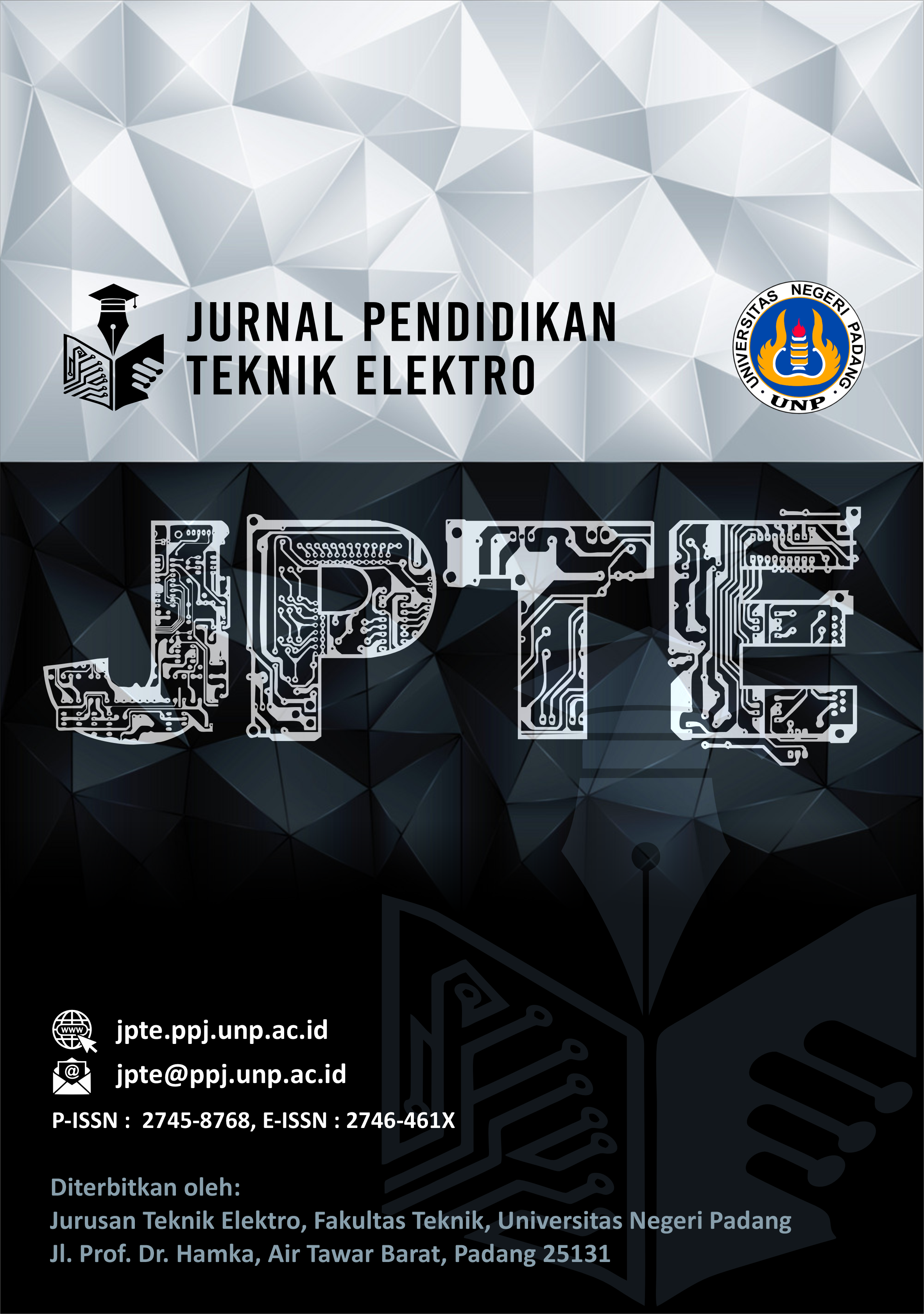Pengaruh Pengetahuan Keselamatan dan Kesehatan Kerja (K3) terhadap Perilaku Siswa Sesuai K3 pada Pratikum Instalasi Penerangan Listrik
##plugins.themes.academic_pro.article.main##
Abstract
This study aims to determine the effect of K3 knowledge on K3 behavior of class XI TITL students of SMKN 3 OKU. This study was conducted on 34 students by giving posttest questions about K3 knowledge and using an assessment rubric filled in by the researcher. This study is a study that uses a quantitative approach with a descriptive method. Meanwhile, the type of research used is correlational research because it identifies how a variable affects another variable. Based on these results, it can be seen that a student's understanding of theory is very necessary. Theory is one of the most basic things that must be understood by students before carrying out practice. Theory as a starting point for practice is seen as knowledge about something. The importance of K3 knowledge for students is seen from various aspects. First, understanding K3 provides a strong foundation for students to recognize the risks they face. Second, routine training can make students ready to face work conditions. Third, applying K3 in learning creates a collective basis between students.
##plugins.themes.academic_pro.article.details##

This work is licensed under a Creative Commons Attribution 4.0 International License.
References
[2] D. T. P. Yanto, Sukardi, M. Kabatiah, H. Zaswita, and O. Candra, “Analysis of Factors Affecting Vocational Students’ Intentions to Use a Virtual Laboratory Based on the Technology Acceptance Model,” International Journal of Interactive Mobile Technologies, vol. 17, no. 12, pp. 94–111, Jun. 2023, doi: 10.3991/ijim.v17i12.38627.
[3] D. Adriani and J. Sojanah, “Upaya Meningkatkan Kompetensi Siswa Melalui Motivasi Belajar ( the effort to improve competence of students through learning motivation),” Jurnal Pendidikan Manajemen Perkantoran, vol. 2, no. 1, pp. 10–19, 2017.
[4] D. Komarudin, W. S. Kuswana, and R. A. Noor, “Kesehatan Dan Keselamatan Kerja Di Smk,” Journal of Mechanical Engineering Education, vol. 3, no. 1, p. 46, 2016, doi: 10.17509/jmee.v3i1.3192.
[5] C. Wuni et al., “Sosialisasi Budaya Keselamatan Dan Kesehatan (K3) Di Sekolah Pada Siswa Smk Kesehatan Kota Jambi Occupational Health and Safety Culture Socialization for Vocational High School Students in Jambi City,” Jurnal Ilmiah Pengabdian kepada Masyarakat, vol. 8, no. 1, pp. 11–15, 2024.
[6] A. Lusius, “Hubungan antara kesiapan belajar dengan hasil belajar keamanan keselamatan dan kesehatan kerja (k3) pada siswa kelas x jurusan administrasi perkantoran di smkn 3 jakarta,” Universitas Negeri Jakarta, 2012.
[7] S. Komala, “Pengaruh Pengetahuan K3 Terhadap Berperilaku Sesuai K3 Siswa Kelas XI TITL Pada Mata Pelajaran Instalasi Penerangan Listrik di Workshop Listrik SMK Negeri 2 Kota Sungai Penuh,” Universitas Negeri Padang, 2019.
[8] S. Azwar, “Sikap Manusia: Teori dan Pengukurannya,” 2013, doi: https://doi.org/10.1038/cddis.2011.1.
[9] D. A. Kurnia and M. Murinto, “Media Pembelajaran Job Safety Induction Untuk Siswa Baru SMK Negeri 2 Tasikmalaya Program Keahlian MesinBerbasis Multimedia,” JSTIE (Jurnal Sarjana Teknik Informatika) (E-Journal), vol. 7, no. 3, p. 174, 2019, doi: 10.12928/jstie.v7i3.12387.
[10] A. Aswardi, D. T. P. Yanto, C. Dewi, H. Zaswita, M. Kabatiah, and R. Kurani, “Human Machine Interface-Based Control Training Kit as Innovative Learning Media to Enhance Students’ Automation Control Skills in the Industry 4.0 Era,” TEM Journal, vol. 12, no. 4, pp. 2157–2165, 2023, doi: 10.18421/TEM124-26.
[11] I. S. Muthalib, “Sosialisasi Budaya K3 (Kesehatan Keselamatan Kerja) untuk Usia Dini di Tingkat Sekolah Dasar IKIP 2 Kota Makassar,” JURNAL TEPAT : Applied Technology Journal for Community Engagement and Services, vol. 1, no. 1, pp. 17–22, 2018, doi: 10.25042/jurnal_tepat.v1i1.22.
[12] E. Zebua, Y. Telaumbanua, A. Lahagu, E. Suka Adil Zebua, E. Telaumbanua, and A. Lahagu, “Pengaruh Program Keselamatan Dan Kesehatan Kerja Terhadap Motivasi Kerja Karyawan Pada Pt. Pln (Persero) Up3 Nias,” Jurnal EMBA, vol. 10, no. 4, pp. 1417–1435, 2022.
[13] Mubarak, Promosi Kesehatan Untuk Kebidanan. Jakarta: PT. Salemba Medika, 2011.
[14] A. S. R. I. Putri, “Penerapan Prosedur Kerja Aman, Penggunaan APD, Pelatihan Dan Pengetahuan K3 Terhadap Kejadian Kecelakaan Kerja Pada Pekerja Di Bagian Produksi Di PT. Industri Kapal Indonesia (PERSERO) Makassar,” 2021.
[15] O. Candra, A. Putra, S. Islami, D. T. P. Yanto, R. Revina, and R. Yolanda, “Work Willingness of VHS Students at Post-Industrial Placement,” TEM Journal, vol. 12, no. 1, pp. 265–274, Feb. 2023, doi: https://doi.org/10.18421/TEM121-33.
[16] Priyoto, Teori sikap dan perilaku dalam kesehatan : dilengkapi contoh kuesioner / Priyoto. 2014.
[17] A. Suharsimi, Prosedur Penelitian Suatu Pendekatan Praktik. Jakarta: Rineka Cipta, 2013.
[18] A. Hendrawan, “Gambaran Tingkat Pengetahuan Tenaga Kerja Pt’X’ Tentang Undang-Undang Dan Peraturan Kesehatan Dan Keselamatan Kerja,” Jurnal Delima Harapan, vol. 6, no. 2, pp. 69–81, 2019, doi: 10.31935/delima.v6i2.76.
[19] A. A. W. P. Tyas, “Pentingnya Keselamatan Dan Kesehatan Kerja Dalam Meningkatkan Produktivitas Kerja Karyawan,” Forum Ilmiah, vol. 8, no. 3, pp. 217–223, 2011.

